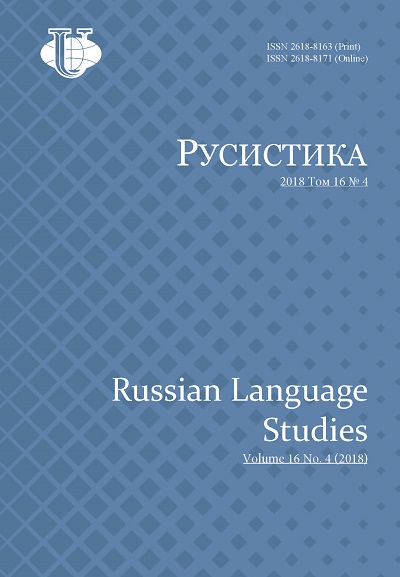“Flipped classroom” as a new method of teaching Russian in Chinese universities: Sichuan University experience
- Authors: Zolotykh L.G.1, Tsiu S1
-
Affiliations:
- Sichuan University
- Issue: Vol 16, No 4 (2018)
- Pages: 451-463
- Section: Methods of teaching russian as a foreign language
- URL: https://journals.rudn.ru/russian-language-studies/article/view/20268
- DOI: https://doi.org/10.22363/2618-8163-2018-16-4-451-463
- ID: 20268
Cite item
Full Text
Abstract
This article describes the implementation of the analytical project introducting the “Flipped classroom” method into teaching the Russian language in Chinese universities. The theoretical foundations of the “Flipped classroom” model are presented in the article as an innovative methodology, which the authors use in the process of teaching a foreign language to increase students’ motivation and future linguists and translators’ quality of knowledge and skills. The problematic of the article is defined by the commitment to traditional nationally conditioned methods in the class modeling and teacher-student communication in China. The relevance of the study is determined by the main methods of correcting the education stages, which allow the teacher to intensify the students’ activity not only in applying the acquired knowledge, but also in getting new knowledge and skills independently. The article analyzes the experiment conducted within the course “Grammar of the Russian Language”, which revealed that the “Flipped classroom” arouses more students’ interest to the Russian language, helps to develop their speech skills and improves their ability to use a variety of language means, releases the lecturer from long hours lectures, provides an opportunity to transform the educational process. The main directions of the “Flipped classroom” are defined, the authors’ system of technologies, particularly focused videocourses created without involving programming specialists are shown. Both positive results and problems of teaching the Russian language by Chinese students with the use of the “Flipped classroom” model are considered. Comparative characteristics and the results of traditional and innovative teaching are presented. The statistical data of the students’ survey and the diagnosis of the knowledge quality, monitoring and evaluation of teaching results are given. The article presents the experience of Russian as a foreign language teaching at the Faculty of the Russian language at Sichuan University.
About the authors
Lidia Glebovna Zolotykh
Sichuan University
Author for correspondence.
Email: zolotykhlg@yandex.ru
Doctor of Philology, Professor, Professor of Sichuan University
29 Wangjianglu St., Chengdu, 610000, The People’s Republic of ChinaS Tsiu
Sichuan University
Email: qiuxin12121@163.com
PhD in Philological Sciences, Dean of the Faculty of Russian Language, Sichuan University
29 Wangjianglu St., Chengdu, 610000, The People’s Republic of ChinaReferences
- Bogdanova, V. (2012). Pedagogicheskii konstruktivizm: obrazovanie kak adaptatsiya. Filosofiya obrazovaniya [Pedagogical Constructivism: Education as Adaptation. Philosophy of Education]. (In Russ.)
- Zhen, H. (2017). Revision of the teacher’s role in terms of self-organizing systems theory. Education and its evaluation. (In Chinese)
- Liu, J., Dai, J., & Xie, Y. (2012). The modern theory of self-organizing systems and their application in the sphere of education. Distant education. (In Chinese)
- Passov, E., & Kuzovleva, N. (2010). Osnovy kommunikativnoi teorii i tekhnologii inoyazychnogo obrazovaniya: metodicheskoe posobie dlya prepodavatelei russkogo yazyka kak inostrannogo. [Fundamentals of communicative theory and technology of foreign language education: a methodical guide for teachers of Russian as a foreign language]. Moscow: Russian language. Courses Publ. (In Russ.)
- Sergeyev, S. (2008). Konstruktivizm: kontsept «znanie». Filosofiya obrazovaniya [Constructivism: the concept “knowledge”. Philosophy of Education]. (In Russ.)
- Qiao, G. & Li, N. (2018). Theoretical explanation of B. Bloom’s theory “The Complete Learning of Knowledge” and its revelation. Pedagogical Science. (In Chinese)
- Zhang, P., & Mazur, E. (2010). Peer-Instrustion — a new method of teaching physics at Harvard University. Education in Chinese universities. (In Chinese)
- Zhang, J. (2016). Russian language teaching on the basis of the cognitive constructive theory. Review of science and education. (In Chinese)
- Zhang, J., Sun, D., & Wang, X. (2015). About the reform Russian language reaching in universities on the basis of the “Inverted Class”. Scientific Journal of Heihe. (In Chinese)
- Baker, J. W. (2000). The classroom flip: using web course management tools to become the guide by the side. In Chambers J.A. (Ed.). Selected Papers from the 11th International Conference on College Teaching and Learing. Florida: Florida Community College, Jacksonville.
- Hamdan, N., McKnight, P., McKnight, K., & Arfstrom, K.M. A Review of Flipped Learning. Flipped Learning Network. Retrieved June 10, 2018 from https://doi.org/10.1016/j.compedu.2015.07.008
- Koller, D. Death Knell for the Lecture: Technology as a Passport to Personalized Education. Retrieved June 18, 2018 from https://immagic.com/eLibrary/ARC-HIVES/GENERAL/GENPRESS/ N111205K.pdf
- Marcey, D.J., & Brint, M.E. Transforming an undergraduate introductory biology course through cinematic lectures and inverted classes: a preliminary assessment of the CLIC model of the flipped classroom. Retrieved June 18, 2018 from https://www.nabt.org/websites/institution/File/docs/pdf
- Mazur, E. Peer instruction. Retrieved June 18, 2018 from https://www.colorado.edu/physics/phys4810/ phys4810_readings/mazur.pdf
- Mazur, E. (1997). Peer Instruction: A User’s Manual. Upper Saddle River, NJ: Prentice Hall.
Supplementary files














